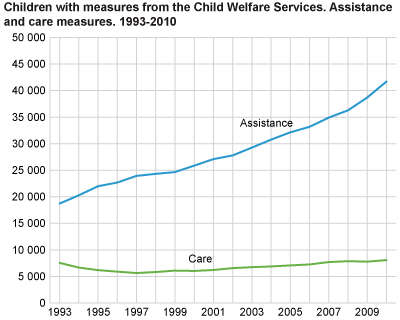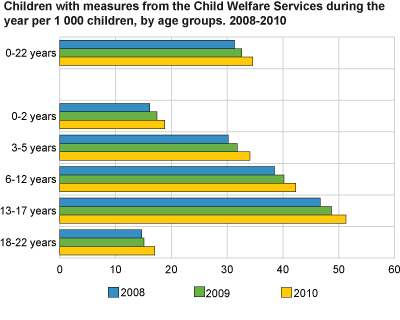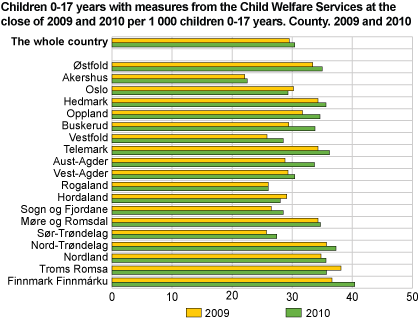Content
Published:
This is an archived release.
Largest increase since 1993 in children receiving child welfare measures
Almost 50 000 children received measures from the Child Welfare Services in 2010; an increase of more than 7 per cent compared to 2009. In total figures, this amounted to almost 3 300 children, resulting in the largest rise since 1993 when the new Child Welfare Act was passed by parliament.
Of all the children that received measures from the Child Welfare Services in 2010, the majority, around 84 per cent, received assistance measures. The remaining 16 per cent received care measures, which have a higher degree of intervention, and a total of more than 8 000 children were in this category in 2010. The use of these two main categories of measures has gone through a pronounced change over the years. In 1993 the care measures covered 29 per cent1 of the total use of measures, as mentioned this share is 16 per cent in 2010. There are two explanations for this, first there has been a clear shift during these 18 years to focus more on using assistance measures in the child welfare services, and second that the Child Welfare Services have expanded the type of assistance measures that they offer.
Parents main initiators of investigation cases
In 2010 almost 32 900 investigation cases were initiated, which is an increase of 2 700, or 9 per cent since 2009. Parents took the initiative for investigation in more than 13 per cent of the cases in 2010. This is only marginally more than the categories schools and Child Welfare Services and Police. All together these three categories took the initiative in more than 50 per cent of the investigation cases. The most important reason for investigations in 2010 is by far conditions in the home. This category is set as the reason for more than 55 per cent of the investigations.
Advice and guidance most used measure
Investigation cases can result in children receiving measures from the Child Welfare Services. There are 28 categories of measures in this statistics, and in 2010 the most commonly used was advice and guidance, covering around 34 per cent of the children receiving measures. Two categories that also have high shares are visit home and economic assistance, both having a share of more than 21 per cent. It is worth noting that the measures just mentioned and which are most commonly used are all assistance measures.
Teenagers receive most measures
In 2010, children aged 13-17 have the highest degree of measures received in the child and youth population, more than 50 per 1 000 children in this age category receive child welfare measures. A closer look at the total figures for the same year reveals that there are 16 466 children in the age category 13-17 receiving child welfare services.
More measures for boys than girls
As in previous years, there are more boys than girls receiving assistance from the child welfare service; in total 27 400 boys and 22 400 girls received assistance in 2010.
Thousands of new children receive child welfare services
In 2010 there were 13 700 children with child welfare measures who were not registered in these statistics the previous year, meaning that they were new children for the Child Welfare Services. This figure has increased by almost 8 per cent since 2009. The new children received almost only assistance measures, with a share of 96 per cent.
More money to the Child Welfare Services
The total expenditure for the municipal Child Welfare Services climbed with NOK 930 million from 2009, and totalled almost NOK 7.7 billion in 2010. By the end of 2010 the Child Welfare Services consisted of 3 526 work years; an increase of 111 work years compared to 2009 and a rise of more than 3 per cent.
| 1Figure corrected 30 June 2011 |
Tables:
- Table 1 Children with measures from the Child Welfare Services during the year and per 31 December, by type of measure. Municipality. 2010
- Table 2 Children with measures from the Child Welfare Services during the year, per 31 December and new cases of children with measures, by type of measure, region and county. 1987-2010
- Table 3 Children with measures from the Child Welfare Services during the year, and per 31 Desember and new cases of children with measures. Figures by sex and age. Absolute figres 0-22 years and per 1 000 children 0-17 years. 1997-2010
- Table 4 Children with measures from the Child Welfare Services during the year, by type of measures, age and sex. 2010
- Table 5 Children with measures from the Child Welfare Services, during the year, by age and type of measures. 2010
- Table 6 Children with meaures from the Child Welfare Services during the year, by sex and type of measures. 2010
- Table 7 Children with measures from the Child Welfare Services per 31 December, by age and type of assistance. 2010
- Table 8 Children with placement measures per 31 December, by age and type of measures. 2010
- Table 9 Children with placement measures per 31 December, by age and type of measures 2010, assistance and care, and by region and county. 2007-2010
- Table 10 New cases of children with measures from the Child Welfare Services, by age and reason for measures. 2010
- Table 11 New cases of children with measures from the Child Welfare Services, by age and type of measures. 2002-2010
- Table 12 New cases of children with measures from the Child Welfare Services, by age and who reported the case. 2010
- Table 13 Investigation cases started and closed, by conclusion and sex, age and county. 1993-2010
- Table 14 Cases investigated by the Child Welfare Services, by reason for investigation and who reported the case. 1997-2010
- Table 15 Investigation cases closed, by duration of procedure and county. 1997-2010
- Table 16 Investigation cases closed, by conclusion and who reported the case. 2010
- Table 17 Children moved during the year, by age and number of moves. 2010
- Table 18 Man-years in the child welfare Services per 31 December, by county. 1993-2010
- Table 19 Man-years in the Child Welfare Services per 31 December, by municipality. 2010
Contact
-
Tone Dyrhaug
E-mail: tone.dyrhaug@ssb.no
tel.: (+47) 40 90 24 20
-
Unni Beate Grebstad
E-mail: unni.grebstad@ssb.no
tel.: (+47) 94 50 68 66



